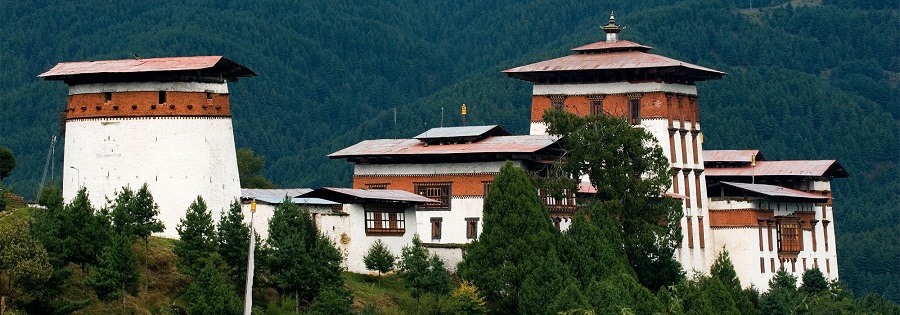
This region that spans from 2,600-4,500 m is the religious heartland of the nation and home to some of its oldest Buddhist temples and monasteries. Tales of Guru Padmasambhava and the tertons (“religious treasure-discoverers”) still linger in this sacred region.
Bumthang Dzongkhag consists of four main valleys, Ura, Chumey, Tang and Choekhor. Choekhor is the largest of the four and is widely considered as ‘Bumthang Valley’. The valleys are broad and gentle carved by the ancient glaciers. The wide and scenic valleys draws a large number of tourists each year.
This dzongkhag is one of the most richly endowed districts in terms of historical and spiritual legacy. Some of Bhutan’s oldest and most venerated temples are found in Bumthang, including Jambey Lhakhang. According to legend this ancient temple was built by the Tibetan king Songtsen Gampo in 659 A.D. as part of a chain of 108 simultaneously constructed temples in order to subdue an evil demoness that lay over the Himalayan region. It is the oldest lhakhang in Bhutan. There are numerous other temples and shrines worth visiting in Bumthang and many of them are linked to Guru Rinpoche’s visit in 746 A.D.
The fertile valleys of Bumthang are covered in fields of buckwheat, rice and potatoes. Apple orchards and dairy farms are also common sights here. This serene region is one of the most peaceful places in the kingdom.
This is a bustling little one-street town in Bumthang with an abundance of restaurants and handicrafts stores. Jakar sells a good amount of chugo, a hard, chewy dried cheese snack popular among Bhutanese. Internet cafés and espresso bars have also started to make an appearance here.
Jakar Dzong
The Jakar Dzong or the “Castle of the White Bird” dominates the Chamkhar valley and overlooks the town. Constructed in 1549, by the Tibetan Lam Nagi Wangchuk, the Dzong played an important role as the fortress of defence of the whole eastern Dzongkhags. It also became the seat of the first king of Bhutan.
A special feature of the Dzong is the approximately fifty meters high Utse or the Central tower, which is distinct from most other Dzongs in Bhutan. The other unique feature of the Dzong is a sheltered passage, with two parallel walls, interconnected by fortified towers, which gave the population of the fortress access to water in the case of a siege. The protected water supply is still intact to this day.
Mebar Tsho ( Burning Lake)
According to legend Terton Pema Lingpa had a vision of the sacred treasures that Guru Rimpoche had hidden within the lake centuries earlier. However, the people of Tang and the local ruler were cynical of his claims. In order to prove his claims, Pema Lingpa held a butter lamp in his hand as he jumped into the lake. After remaining under water for a long time he re-emerged holding a chest and a scroll of paper with the butter lamp held in his hand still burning bright. Thereafter, the lake came to be known as Mebartsho (the burning Lake).
The Burning Lake, Mebar Tsho is located along the way to the Tang village over the feeder road under Bumthang valley. It takes approximately thirty minutes’ drive to the Mebar Tsho from Chamkhar town.
Mebar Tsho is considered one of the most sacred sites in the region as it is related to the renowned religious treasurer (Terton) Terton Pema Lingpa. Pema Lingpa is considered an incarnated disciple of Padmasambhava who discovered treasure within the lake in late 15th century.
Today, this small fresh water lake is a sacred pilgrimage site for the Bhutanese with bright multicolored prayer flags surrounding it and a small altar dedicated to Terton Pema Lingpa has also been set up. On auspicious days people offer butter lamps at the lake. Many tourists visit the site to observe spectacular beauty of this important historical and religious site.
